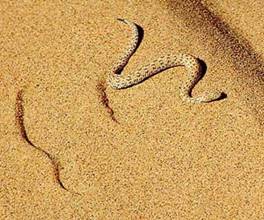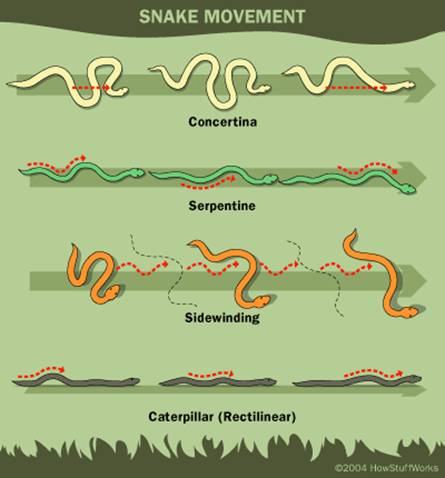
Coral Snake
Ancestory and Evolution
Body Structure
Eastern
Feeding
Reproduction
Western
Snake Locomotion
Although we usually say that snakes crawl, they can actually move in different ways- serpentine movement, concertina movement, rectilinear creeping, and sidewinding. The type of movement used depends largely on the terrain.
In serpentine movement, the snakes body is bent into horizontal loops by the contraction of muscles on the inner side of each loop. As the contractions move along the snake, a series of waves passes from the head backward. On land, serpentine movement is only possible where there are irregularities in the ground for waves to push against, propelling the snake forward. Snakes also use this movement when swimming, with the water taking the place of irregularities propelling the snake forward.
Concertina movement is used when crawling over difficult terrain or in a confined space such as a burrow. The snake wedges the back part of its body and extends the rest of the body forward as much as possible. It then wedges the head and “concertinas” the front of the body, drawing itself forward. The snake then wedges the back part and repeats the process.
 Rectilinear creeping is used particularly by large and heavy snakes, and allows them to move in a straight line. The snake uses the muscles joining the vertical scales to the ribs, contracting them in waves down the body. The ventral scales grip onto irregularities in the ground, and the snake is propelled forward in a seamlessly effortless gliding motion.
Rectilinear creeping is used particularly by large and heavy snakes, and allows them to move in a straight line. The snake uses the muscles joining the vertical scales to the ribs, contracting them in waves down the body. The ventral scales grip onto irregularities in the ground, and the snake is propelled forward in a seamlessly effortless gliding motion.
Sidewinding relies least on a firm surface to push against and is used by snakes living in areas with shifting surfaces, such as desert sands. In sidewinding the snake shifts itself by moving sideways in a series of steps at an angle of about 45 degrees to the line of the body. The snake lifts its head off the ground and thrusts it to the side. As the head touches the ground, the body follows, lifted across by a loop that travels down to the tail using the vertical pressure at the point of contact to prevent the snake from slipping. The head is then lifted and moved sideways again. The track left is a series of parallel lines in the sand where the snake was in contact with the ground.
In the past, exaggerated claims have been made about a snakes speed. However they move, the majority are slow. The fastest snake in the world is the black mamba which moves 20mph at its fastest. Even so, this is rare, and often the speed is 10 mph.
